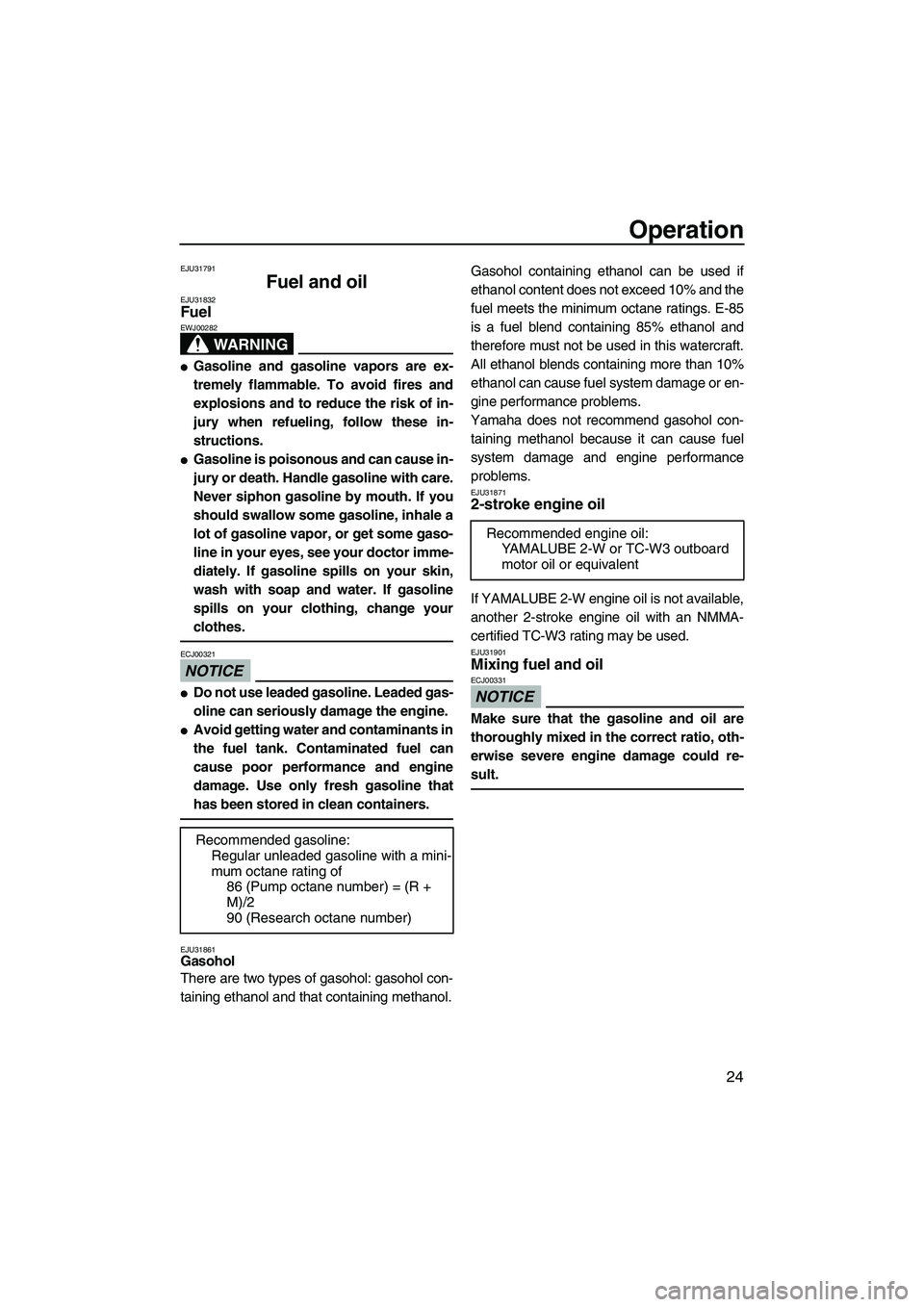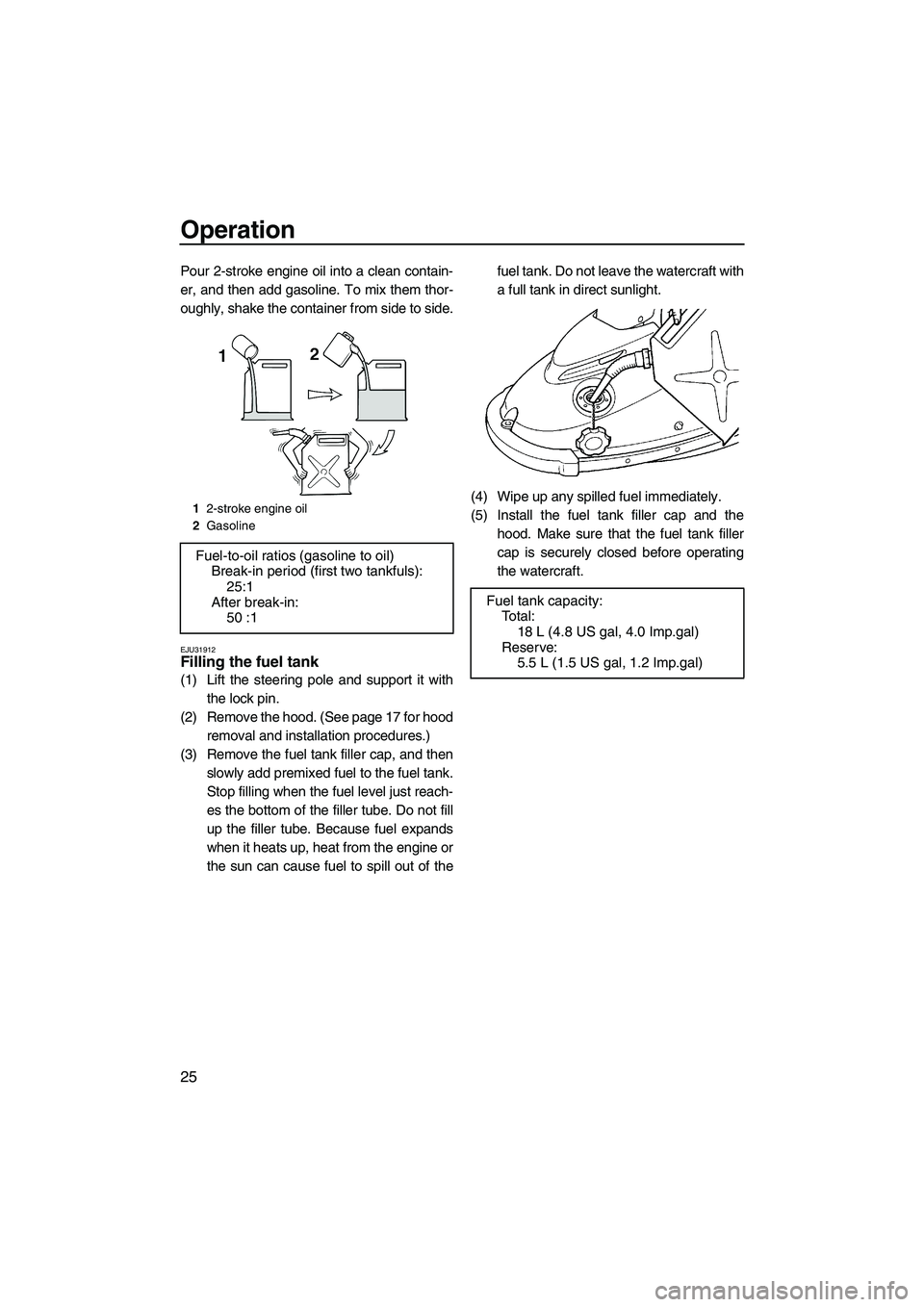Page 23 of 76
Features and functions
16
1Fire extinguisher container
2Fuel cock knob
3Choke knob
4Clip
5Start switch
6Throttle lever
7Engine shut-off switch
8Engine stop switch
9Engine shut-off cord (lanyard)
10Bow
11Fuel tank
12Battery
13Silencer
14Spark plugs/Spark plug caps
15Muffler
16Water separator
17Fuel filter
18Flushing hose connector
19Electrical box
UF2F71E0.book Page 16 Thursday, April 10, 2008 11:47 AM
Page 26 of 76

Features and functions
19
The fuel cock knob positions are explained as
follows and are shown in the illustration.
OFF:
With the fuel cock knob in this position, fuel
does not flow. Always turn the fuel cock knob
to this position when the engine is not running.
ON:
With the fuel cock knob in this position, fuel
flows to the carburetors. Turn the fuel cock
knob to this position when starting the engine
and operating the watercraft.
RES:
This indicates reserve. With the fuel cock
knob in this position, the fuel reserve is made
available. Turn the fuel cock knob to this posi-
tion if you run out of fuel while operating the
watercraft. When this occurs, refuel as soon
as possible and be sure to turn the fuel cock
knob back to “ON”.EJU31150Engine stop switch
Push the engine stop switch (red button) to
stop the engine normally.
EJU31161Engine shut-off switch
Attach one end of the engine shut-off cord
(lanyard) to your left wrist, and then insert the
clip on the other end under the engine shut-off
switch (black button). The engine will stop au-
tomatically when the clip is removed from the
switch, such as if the operator falls off the wa-
tercraft. Remove the engine shut-off cord
(lanyard) from the watercraft when the engine
1Fuel cock knob
1Engine stop switch
UF2F71E0.book Page 19 Thursday, April 10, 2008 11:47 AM
Page 27 of 76
Features and functions
20
is not running to prevent unauthorized use by
children or others.
EJU31171Start switch
Push the start switch (green button) to start
the engine.
The engine will not start when the clip is re-
moved from the engine shut-off switch.
EJU31200Choke knob
Starting a cold engine requires a richer air-fuel
mixture, which is supplied by the choke.
Pull the choke knob out to turn the choke on.
Push the choke knob in to turn the choke off.
EJU31210Throttle lever
Squeeze the throttle lever to increase engine
speed.
Release the throttle lever to decrease engine
speed or to return it to the idle position.
EJU31220Cooling water pilot outlet
This watercraft is equipped with a cooling wa-
ter pilot outlet.
1Engine shut-off cord (lanyard)
2Clip
3Engine shut-off switch
1Start switch
1Choke knob
1Throttle lever
UF2F71E0.book Page 20 Thursday, April 10, 2008 11:47 AM
Page 28 of 76

Features and functions
21
When the engine is running, cooling water is
circulated in the engine, and then it is dis-
charged from the pilot outlet.
To check for proper operation of the cooling
system, check that water is being discharged
from the pilot outlet. If water is not being dis-
charged from the outlet, cooling water may
not be circulating in the engine. When this oc-
curs, stop the engine and check for the cause.
(See pages 22 and 63 for more information.)
TIP:
�If the cooling water passages are dry, it will
take about 20 seconds for the water to
reach the outlet after the engine is started.
�Water discharge may not be constant at
idle, therefore, open the throttle a little to
check that water discharges properly.
EJU35930Steering system
Your watercraft can be steered by turning the
handlebars in the direction you wish to travel.
When the handlebars are turned, the angle of
the jet thrust nozzle is changed, and the direc-
tion of the watercraft is changed accordingly.
Since the strength of the jet thrust determines
the speed and degree of a turn, throttle must
always be applied when attempting a turn, ex-
cept at trolling speed.
The angle of the jet thrust nozzle can be ad-
justed to suit operator preference. (See page
53 for adjustment procedures.)
1Handlebar
2Jet thrust nozzle
UF2F71E0.book Page 21 Thursday, April 10, 2008 11:47 AM
Page 29 of 76

Features and functions
22
EJU31270Steering pole
The steering pole varies in height with the op-
erator’s posture, enabling the operator to as-
sume various riding positions.
When removing the hood for pre-operation
checks, maintenance, etc., lift the steering
pole and use the lock pin to support it. Move
the lock pin into the detent. Make sure that the
lock pin is returned to the stowed position af-
ter installing the hood.
EJU36000Bow rope hole
The bow rope hole is located at the bow of the
watercraft.The bow rope hole is used to attach a rope to
the watercraft when transporting, mooring, or
towing it in an emergency.
EJU36010Stern rope hole
The stern rope hole is located at the stern of
the watercraft.
The stern rope hole is used to attach a rope to
the watercraft when mooring it.
EJU31661Engine overheat warning system
This model is equipped with an engine over-
heat warning system.
If the engine starts to overheat, the engine
speed will be limited to about 3400 r/min.
If this occurs, immediately reduce the engine
speed, return to shore, and then check for wa-
ter discharge at the cooling water pilot outlet
while the engine is running. If there is no dis-
charge of water, check the intake grate and
1Steering pole
2Lock pin
1Bow rope hole
1Stern rope hole
UF2F71E0.book Page 22 Thursday, April 10, 2008 11:47 AM
Page 30 of 76
Features and functions
23
impeller. (See page 63 for checking proce-
dures.) NOTICE: If you cannot locate and
correct the cause of the overheating, con-
sult a Yamaha dealer. Continuing to oper-
ate at higher speeds could result in severe
engine damage.
[ECJ00041]
EJU31672
Storage pouch
A storage pouch is provided on the underside
of the hood for the owner’s/operator’s manual,
tool kit, and other small items.
Bend the owner’s/operator’s manual slightly
to insert it into the storage pouch, and then
add the tool kit and any other small items.
Fold the pouch, and then wrap the strap
around it. Install the storage pouch on the
hood and secure it with the bands.The storage pouch is not waterproof. If you
carry objects that must be kept dry, such as
the manual, put them in a waterproof bag.
1Storage pouch
1Band
UF2F71E0.book Page 23 Thursday, April 10, 2008 11:47 AM
Page 31 of 76

Operation
24
EJU31791
Fuel and oil EJU31832Fuel
WARNING
EWJ00282
�Gasoline and gasoline vapors are ex-
tremely flammable. To avoid fires and
explosions and to reduce the risk of in-
jury when refueling, follow these in-
structions.
�Gasoline is poisonous and can cause in-
jury or death. Handle gasoline with care.
Never siphon gasoline by mouth. If you
should swallow some gasoline, inhale a
lot of gasoline vapor, or get some gaso-
line in your eyes, see your doctor imme-
diately. If gasoline spills on your skin,
wash with soap and water. If gasoline
spills on your clothing, change your
clothes.
NOTICE
ECJ00321
�Do not use leaded gasoline. Leaded gas-
oline can seriously damage the engine.
�Avoid getting water and contaminants in
the fuel tank. Contaminated fuel can
cause poor performance and engine
damage. Use only fresh gasoline that
has been stored in clean containers.
EJU31861Gasohol
There are two types of gasohol: gasohol con-
taining ethanol and that containing methanol.Gasohol containing ethanol can be used if
ethanol content does not exceed 10% and the
fuel meets the minimum octane ratings. E-85
is a fuel blend containing 85% ethanol and
therefore must not be used in this watercraft.
All ethanol blends containing more than 10%
ethanol can cause fuel system damage or en-
gine performance problems.
Yamaha does not recommend gasohol con-
taining methanol because it can cause fuel
system damage and engine performance
problems.
EJU318712-stroke engine oil
If YAMALUBE 2-W engine oil is not available,
another 2-stroke engine oil with an NMMA-
certified TC-W3 rating may be used.
EJU31901Mixing fuel and oil
NOTICE
ECJ00331
Make sure that the gasoline and oil are
thoroughly mixed in the correct ratio, oth-
erwise severe engine damage could re-
sult.
Recommended gasoline:
Regular unleaded gasoline with a mini-
mum octane rating of
86 (Pump octane number) = (R +
M)/2
90 (Research octane number)
Recommended engine oil:
YAMALUBE 2-W or TC-W3 outboard
motor oil or equivalent
UF2F71E0.book Page 24 Thursday, April 10, 2008 11:47 AM
Page 32 of 76

Operation
25
Pour 2-stroke engine oil into a clean contain-
er, and then add gasoline. To mix them thor-
oughly, shake the container from side to side.
EJU31912Filling the fuel tank
(1) Lift the steering pole and support it with
the lock pin.
(2) Remove the hood. (See page 17 for hood
removal and installation procedures.)
(3) Remove the fuel tank filler cap, and then
slowly add premixed fuel to the fuel tank.
Stop filling when the fuel level just reach-
es the bottom of the filler tube. Do not fill
up the filler tube. Because fuel expands
when it heats up, heat from the engine or
the sun can cause fuel to spill out of thefuel tank. Do not leave the watercraft with
a full tank in direct sunlight.
(4) Wipe up any spilled fuel immediately.
(5) Install the fuel tank filler cap and the
hood. Make sure that the fuel tank filler
cap is securely closed before operating
the watercraft.
12-stroke engine oil
2Gasoline
Fuel-to-oil ratios (gasoline to oil)
Break-in period (first two tankfuls):
25:1
After break-in:
50 :1
Fuel tank capacity:
To t a l :
18 L (4.8 US gal, 4.0 Imp.gal)
Reserve:
5.5 L (1.5 US gal, 1.2 Imp.gal)
UF2F71E0.book Page 25 Thursday, April 10, 2008 11:47 AM